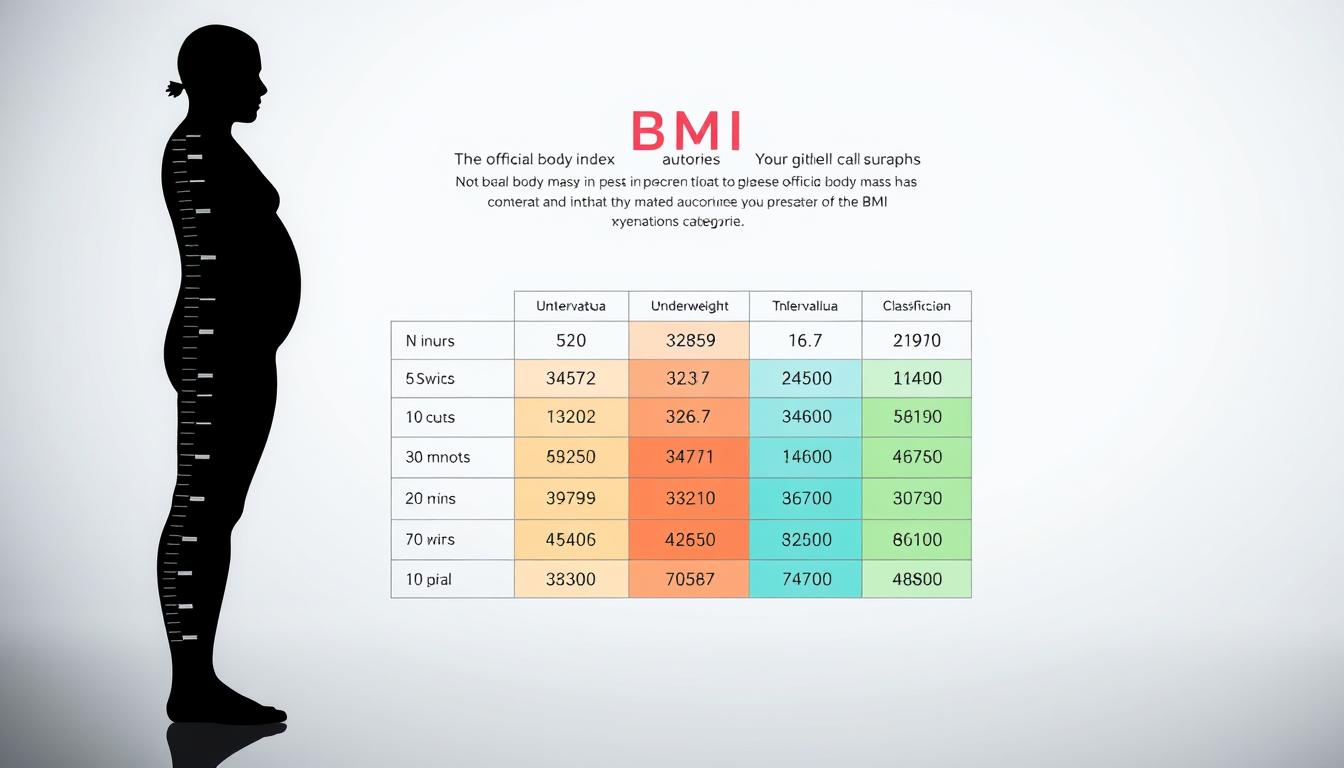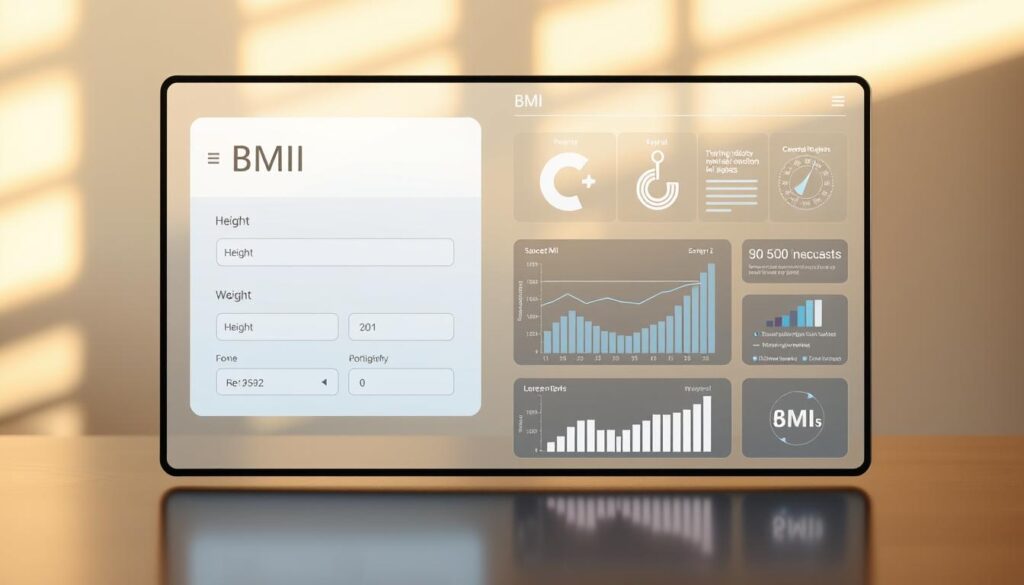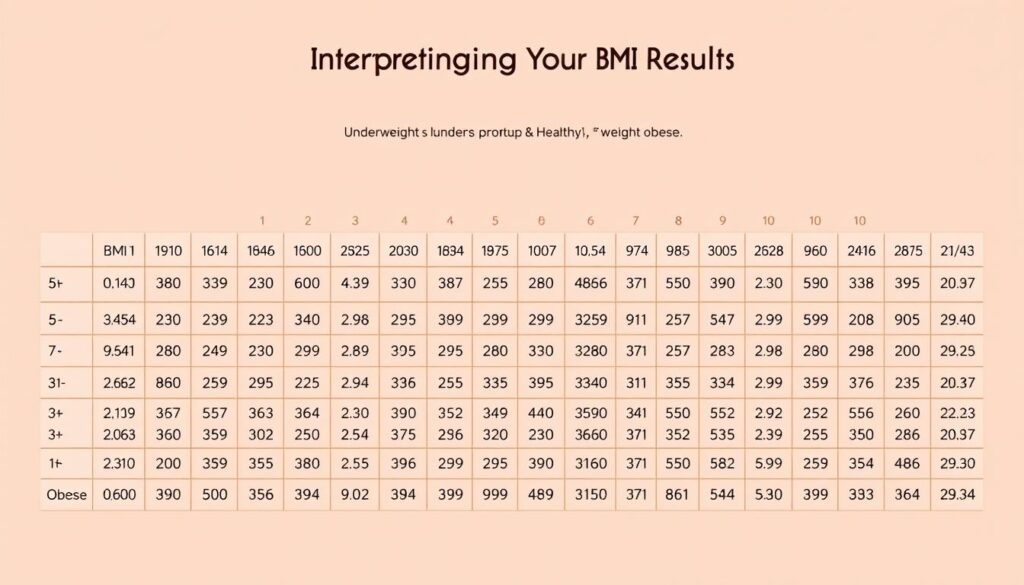Do you know your ideal weight based on your height? How does it affect your health? Knowing our Body Mass Index (BMI) is key to seeing if we have a healthy weight.
We use a BMI calculator to figure out our BMI. It’s a way to measure body fat based on height and weight. It works for adult men and women. By calculating our BMI, we can tell if we’re underweight, normal, overweight, or obese.
To lose weight effectively and improve our body shape, knowing our BMI is just the beginning. We can then set achievable goals and monitor our progress. This is all covered in our guide on BMI weight loss strategies.
Key Takeaways
- Understanding BMI helps assess healthy body weight.
- BMI categories include underweight, normal weight, overweight, and obese.
- Using a BMI calculator is the first step in setting weight loss goals.
- Achieving a healthy BMI can improve overall health and reduce disease risk.
- Regular BMI checks help track progress and adjust weight loss strategies.
What is a BMI Calculator and Why is it Important?
A BMI calculator helps figure out if your weight is healthy for your height. It makes it easy to find out your Body Mass Index. This gives you a quick look at your health.
Definition of BMI
Body Mass Index (BMI) is a simple way to check if you’re at a healthy weight. It uses your height and weight. It’s found by dividing your weight in kilograms by your height in meters squared (kg/m^2).
BMI Categories:
- Underweight: BMI
- Normal weight: BMI = 18.5-24.9
- Overweight: BMI = 25-29.9
- Obese: BMI ≥ 30
How the Calculator Works
A BMI calculator takes your height and weight to calculate your BMI. It uses the formula: BMI = weight (in kg) / height (in meters)^2. For example, if you weigh 70 kg and are 1.75 meters tall, your BMI is 22.86. This means you’re at a healthy weight.
Benefits of Knowing Your BMI
Knowing your BMI has many health benefits. It can show you health risks like diabetes and heart disease. It also motivates you to make healthier lifestyle choices.
“Maintaining a healthy weight is crucial for overall health and wellbeing.” Health experts agree on this. Calculating your BMI is the first step to a healthier life.
The benefits of knowing your BMI include:
- Assessing your weight status
- Identifying potential health risks
- Motivating lifestyle changes
- Monitoring the effectiveness of weight loss or gain efforts
How to Calculate Your BMI
Calculating your BMI is easy. You just need to use a simple formula. It uses your weight and height to find your body mass index.
Step-by-Step Calculation Process
To find your BMI, you need your weight in kilograms and height in meters. The BMI formula is: BMI = weight (kg) / height (m)2.
Here’s how to do it:
- Measure your weight in kilograms.
- Measure your height in meters.
- Square your height (i.e., multiply it by itself).
- Divide your weight by the squared height.
For example, if you weigh 70 kg and are 1.75 m tall, your BMI is 70 / (1.75)2 = 22.86.
Understanding BMI Categories
After calculating your BMI, you can see where you fit. The World Health Organization has set categories:
| BMI Category | BMI Range |
|---|---|
| Underweight | Less than 18.5 |
| Normal weight | 18.5 – 24.9 |
| Overweight | 25 – 29.9 |
| Obese | 30 or more |
Tools and Resources for Calculation
If you don’t like doing math, there are online tools and apps for you. They ask for your height and weight. Then, they tell you your BMI and what category you’re in.
These tools also have extra features. They let you track your weight, give health advice, and help you set weight goals.
Interpreting Your BMI Results
Your BMI result is more than just a number. It’s a key to understanding your health status. Once you have calculated your BMI, it’s essential to understand what your result means in terms of your health.
Healthy BMI Ranges
A healthy BMI range is between 18.5 and 24.9. This range means your weight is in a healthy proportion to your height. Keeping your BMI in this range can significantly reduce the risk of health problems.
To better understand how BMI is categorized, let’s look at the standard BMI chart:
| BMI Category | BMI Range | Health Risk |
|---|---|---|
| Underweight | Less than 18.5 | High |
| Normal weight | 18.5 – 24.9 | Low |
| Overweight | 25 – 29.9 | Moderate |
| Obese | 30 or greater | High |
Implications of High or Low BMI
Having a BMI outside the healthy range can have significant health implications. For instance, a BMI that is too low may indicate underweight. This can lead to health issues such as weakened immunity and osteoporosis. On the other hand, a high BMI, indicating overweight or obesity, is associated with increased risks of chronic diseases like diabetes, heart disease, and certain cancers.
For more detailed information on how BMI is categorized and its implications, you can visit AACE’s BMI Chart Explained page.
When to Seek Professional Help
If your BMI is outside the healthy range, it is advisable to consult with a healthcare professional. They can provide personalized advice and guidance based on your overall health, not just your BMI. This is crucial if you are considering significant changes to your diet or exercise routine.
Understanding your BMI is just the first step. Taking appropriate action based on your BMI result is crucial for maintaining or achieving good health.
The Limitations of BMI as an Indicator
BMI is widely used but has its limits. It doesn’t tell the difference between lean body mass and body fat. This can lead to people with a lot of muscle being seen as overweight or obese, even if they’re not.
Factors Affecting BMI Accuracy
Many things can make BMI readings less accurate. For example, age, sex, and ethnicity can change how body fat is distributed. Older people and women tend to have more body fat for the same BMI as younger men.
Athletes or people with a lot of muscle might also have a high BMI without being overweight.
Key factors that can affect BMI accuracy include:
- Age
- Sex
- Ethnicity
- Muscle mass
- Body composition
Alternative Measures of Health
Healthcare experts often look beyond BMI. They use waist circumference, waist-to-hip ratio, and skinfold measurements. Techniques like dual-energy X-ray absorptiometry (DXA) give detailed body composition info, including bone density and fat distribution.
Combining these methods gives a clearer view of health risks related to weight and body composition.
Importance of Comprehensive Assessments
Assessing health is more than just BMI. It includes looking at diet, exercise, and health markers like blood pressure and cholesterol. For adults using a BMI calculator for adults, remember the result is just part of the picture.
By looking at many factors and talking to health experts, people can get a better understanding of their health. This helps in making targeted plans for improvement.
Tips for Maintaining a Healthy BMI
Keeping a healthy weight is about eating right and staying active. A BMI calculator for women can show you where you stand. It helps guide you to a healthier weight.
Nutrition Advice for a Healthy Weight
Eat a diet full of fruits, veggies, whole grains, and lean proteins. Avoid processed foods and sugary drinks. This helps keep your BMI in check.
The Role of Regular Exercise
Exercise is key for burning calories and boosting health. Try to do at least 150 minutes of moderate exercise or 75 minutes of vigorous exercise each week.
Setting Achievable Health Goals
Setting realistic goals is key to success. Break big goals into smaller steps. Celebrate your progress. This keeps you motivated and helps you reach a healthy BMI.




